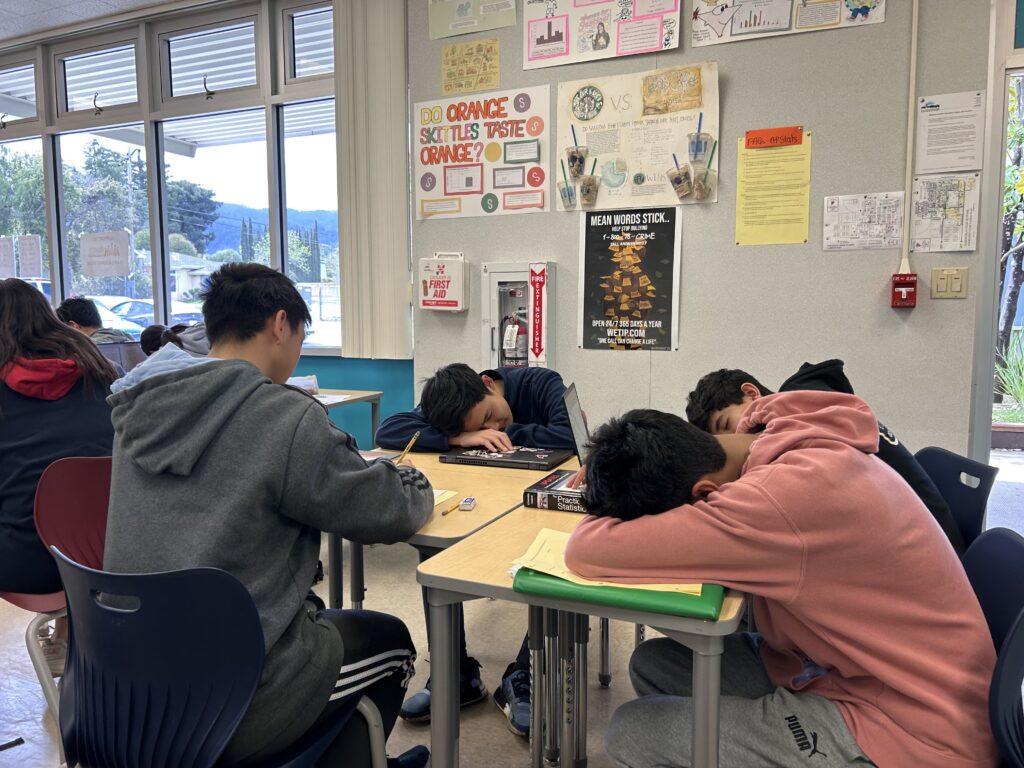Five minutes into a post-lunch class, heads sag as though weighed down by a 45 pound plate strapped to their chins. Having just eaten, they are faced with the difficult tug-and-war against a food coma, trying their best to pay attention and not fall asleep as the teacher tries to explain a concept like morality in English language or chi-test graphs in statistics.
Unfortunately, this battle against sleep is often unsuccessful, with many falling victim to it nearly every school day. Eventually, the food coma wins, with students sleeping until the end of the lesson and not taking in any of the content.
Take, for instance, me and my table mates Shrey Jain, Kabeer Minocha and Pothan Tang in AP Statistics; three of the four can be found consistently sleeping for the duration of certain classes as they give into their lacking sleep schedules, despite being second semester seniors as a result of choosing to sleep in class.
“On average, I sleep about five to six hours every night. I constantly feel tired during class,” Kabeer told me. “It results in me always sleeping during class to try to counteract my lack of sleep.”
Sleeping in class also acts as a kind of real-life time machine: the sleepers effectively jump forward in time until the end of school, resulting in an experience analogous to going home directly after lunch.
However, sleeping in class makes finishing homework particularly challenging, as concepts described by teachers in classes feel completely foreign. As a result, many resort to cramming the day before an exam.
“Studying alone is much more efficient for me because I can study by myself and maintain a better focus. I work better under pressure which results in me working much faster as well,” Shrey said. “I’ll usually study for four hours before tests.”
To prevent himself from sleeping in class, Shrey chooses to participate in AP Statistic teacher Seems Patel’s homework opt-out program, submitting his classwork rather than turning in his homework. This way, he must stay awake to jot down notes and solve classwork problems. Unfortunately, he still sometimes loses the battle against sleep.
Some teachers have tried implementing breaks between their classes to allow students to mentally reset, stretch or use the bathroom. Others have attempted to incorporate more activities into their classes, from projects to games requiring students to be engaged.
“More teachers should do what we do in Spanish class where there is a 5-minute break,” Pothan said.
Sleeping in class is also its own form of contagion. It can very easily contaminate other adjacent tables.
“Some people need to exercise more self restraint. If one falls down, the rest of the table falls down too,” Esabella said. “I get very tired in class, and I get even more tired when I see people in front of me laying their heads down.”
Esabella sits in the same AP Statistics class and struggles to look past multiple tables sleeping when listening to lectures. To prevent falling asleep, her peers would excuse themselves from the classroom to slap their face really hard while others drink a sip of water, Fung said.
Sleeping in class is a double-edged sword. For those who choose to sleep strategically, it can be an excellent way to refresh themselves and obtain an even better understanding of the in class material. Other times, it is involuntary, with students effectively having effectively just skipped the class.
“Sometimes if you fall asleep for a short period of time, you might be really confused when you suddenly wake up,” Esabella said. “However, you’ll feel so much better, so you will be more likely to learn.”

























